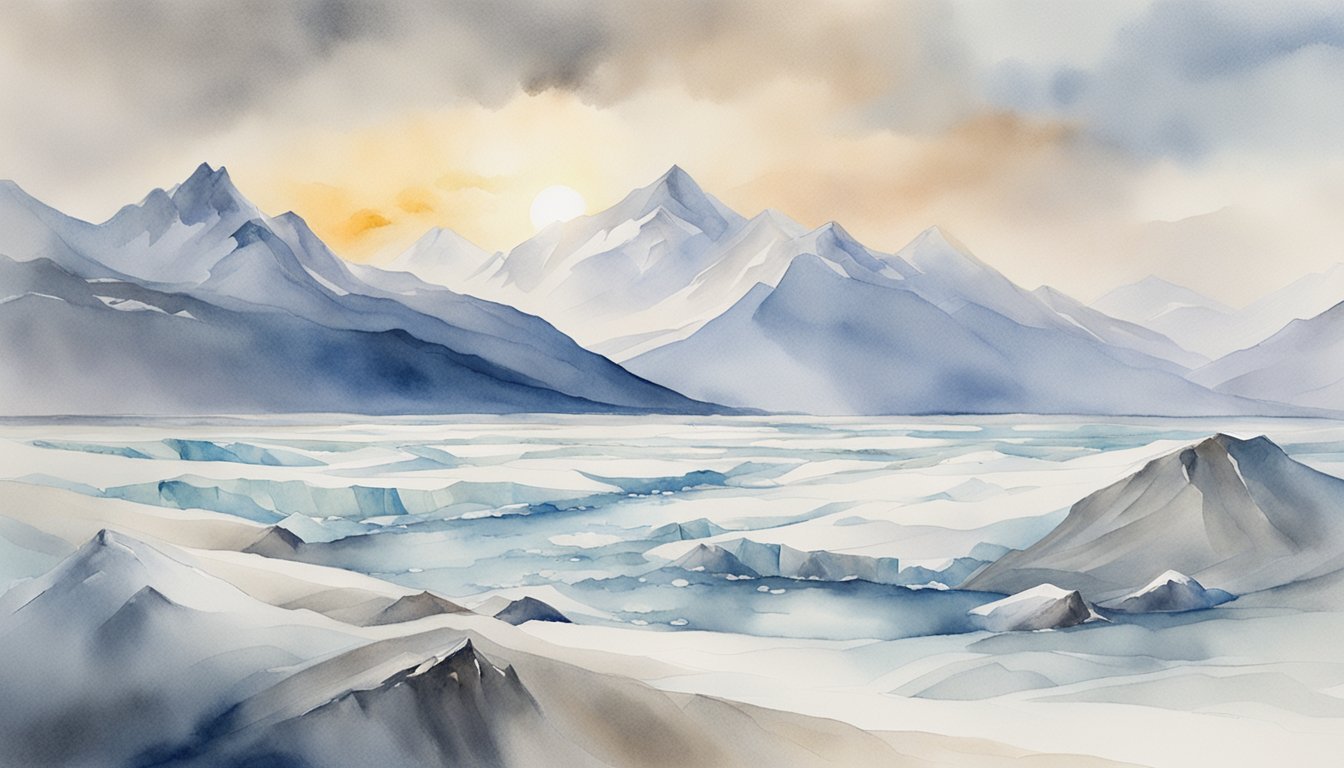Understanding Ice Ages
Ice ages shape the planet’s long-term climate patterns and have profound effects on the geography and biological diversity of Earth. This section explores the historical frequency of ice ages, their causes, the specific influence of Earth’s orbital variations, and the contemporary understanding of how greenhouse gases impact these glacial periods.
Historical Overview of Ice Ages
Ice ages, encompassing both glacial and interglacial periods, are epochs when ice sheets and glaciers expand across the Earth’s surface. Notable throughout Earth’s history, these periods have occurred in a cyclical fashion, with the most recent glacial period ending about 10,000 years ago, ushering in the current interglacial period where warm climates prevail. Records from ocean sediment provide evidence of past ice ages dating back hundreds of millions of years.
Causes of Ice Ages
Ice ages result from complex interactions within the Earth’s climate system, involving atmospheric composition, ocean circulation, plate tectonics, solar radiation, and volcanic activity. Fluctuations in atmospheric carbon dioxide play a critical role, as lower CO2 levels correspond to cooler global temperatures that favor ice sheet expansion.
Milankovitch Cycles and Earth’s Orbit
The theory of Milankovitch Cycles, named after Serbian astrophysicist Milutin Milankovitch, explains that variations in the Earth’s orbit and rotational axis affect the amount of solar radiation reaching the planet, especially in the Northern Hemisphere. These orbital changes include variations in eccentricity, axial tilt, and precession, all contributing to the onset of glacial and interglacial periods.
The Role of Greenhouse Gases
Greenhouse gases, particularly carbon dioxide, play an essential role in regulating the Earth’s climate. Throughout ice ages, lower concentrations of atmospheric carbon dioxide are linked with decreased global temperatures, whereas increases in CO2 are associated with warming trends. This link between CO2 and climate highlights the significance of greenhouse gases in climate change and the potential for human activities to influence long-term climate patterns.
Predicting the Next Ice Age

Understanding when the next ice age will occur involves evaluating a range of factors, including past climate records, current climate trends, and the extensive impact human activity has on Earth’s climate. Scientists employ sophisticated climate models and analyze geological evidence to shed light on these complex interactions.
Climate Models and Projections
Climate models leverage vast amounts of data about Earth’s climate, including temperature, sea level, and ocean circulation, to predict future climate patterns. Researchers particularly look at the Milankovitch cycles, which describe the collective effects of changes in the Earth’s movements upon its climate. These cycles include variations in the Earth’s eccentricity, axial tilt, and precession, and are thought to be responsible for the patterns of glacial and interglacial periods within the current ice age.
Current Global Warming Trends
Global warming refers to the long-term warming trend observed in the global average temperature. At present, this trend is strongly upward, primarily due to the increase in greenhouse gases like carbon dioxide. Observations of melting glaciers in places like Greenland and Antarctica, and shrinking ice cover in the Arctic, are direct effects of this warming trend. Current global temperature rise is affecting the intricate workings of the North Atlantic Ocean circulation, which is integral to regulating climate, particularly in Europe and North America.
Impact of Human Activity
The influence of human activity, particularly the emission of greenhouse gases, cannot be understated. These gases trap heat in the atmosphere and are leading to changes in climate at a rate that has not been seen in the Earth’s climate record. The accelerating melting of polar ice is increasing the amount of freshwater in the ocean, which could have profound effects on global ocean current patterns and potentially lead to a cooling in some regions of the planet, despite the general trend of global warming.
Global Climate Policy and Future Outlook
Future climate scenarios depend heavily on global climate policies aimed at reducing greenhouse gas emissions. The actions taken by countries around the world today will shape the global temperature trajectory. It’s a delicate balance; while some scientists have explored the concept of a new Little Ice Age, most current projections indicate that the ongoing global warming trend is likely to postpone the onset of the next extensive glacial period or ice age for tens of thousands of years.

